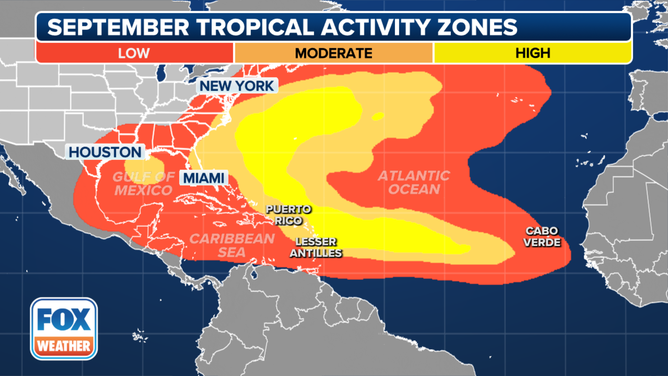Atlantic hurricane season reaches climatological peak Sept. 10
An average Atlantic hurricane season features an additional six named storms after Sept. 10. Four of those six typically become hurricanes, with two becoming major hurricanes (Category 3 or higher).
When will Atlantic hurricane season heat up?
Dr. Jill Trepanier, Louisiana State University professor and hurricane climatologist, explains the factors behind the unusually quiet Atlantic hurricane season we've seen so far and discusses what to expect through the remainder of the season.
Sept. 10 marks the climatological peak of the Atlantic hurricane season, as that's the date when the most tropical storms and hurricanes have roamed the Atlantic Basin in the historical records.
Early to mid-September is the time of year with the most optimal conditions for the formation of tropical cyclones in the Atlantic. This is when sea-surface temperatures reach their warmest levels of the season, upper-level winds in the tropical Atlantic Ocean tend to relax, Saharan dust is less widespread than earlier in the summer, and tropical disturbances frequently roll off the western coast of Africa.

While the Atlantic hurricane season officially runs from June 1 to Nov. 30, Sept. 10 is the date when the most hurricanes and tropical storms have occurred in the historical records.
(FOX Weather)
The combination of these factors opens up more real estate for tropical development during the hurricane season's annual peak than at any other point in the year. The map below shows the vast area where tropical storms and hurricanes typically occur in September, which covers much of the Atlantic Ocean, Caribbean Sea and Gulf of Mexico.
WHERE TROPICAL STORMS AND HURRICANES TYPICALLY OCCUR DURING EACH MONTH OF ATLANTIC HURRICANE SEASON

This map shows where tropical cyclone activity tends to occur during September. The data are shown as the combined number of tropical depressions, tropical storms and hurricanes whose centers pass within 125 miles of a point on the map during a 100-year period.
(FOX Weather)
Even though we've reached the climatological peak, roughly 60% of an average Atlantic hurricane season is still remaining from Sept. 10 through the end of the season on Nov. 30.
The period from August through early October tends to produce the most hurricanes and tropical storms in an average year, with September marking the most active month of the Atlantic hurricane season.
HERE'S WHY THE ATLANTIC HURRICANE SEASON RUNS FROM JUNE TO NOVEMBER
The 2024 Atlantic hurricane season

(FOX Weather)
The Atlantic has spawned six named storms as of Sept. 9. This includes Francine, which is expected to make landfall as a hurricane along the U.S. Gulf Coast this week.
The National Hurricane Center (NHC) is also monitoring a pair of tropical disturbances in the central Atlantic, both of which have the potential to develop into the next named storm of the 2024 season.
According to the NHC, an average season in the Atlantic features an additional six named storms after the Sept. 10 climatological peak. Four of those six typically become hurricanes, with two becoming major hurricanes (Category 3 or higher).
